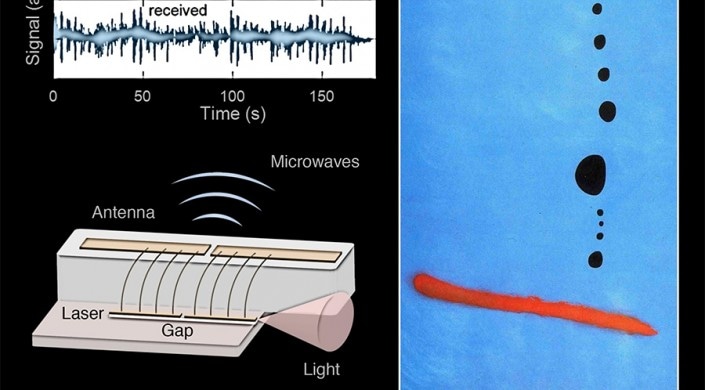Apr 26 2019
Undoubtedly, people would have never heard Dean Martin like this.
 This device uses a frequency comb laser to emit and modulate microwaves wirelessly. The laser uses different frequencies of light beating together to generate microwave radiation. The “beats” emitted from the laser are reminiscent of a painting (right) by Spanish artist Joan Miro' named "Bleu II". The researchers used this phenomenon to send a song wirelessly to a receiver. (Image credit: Marco Piccardo/Harvard SEAS).
This device uses a frequency comb laser to emit and modulate microwaves wirelessly. The laser uses different frequencies of light beating together to generate microwave radiation. The “beats” emitted from the laser are reminiscent of a painting (right) by Spanish artist Joan Miro' named "Bleu II". The researchers used this phenomenon to send a song wirelessly to a receiver. (Image credit: Marco Piccardo/Harvard SEAS).
At the Harvard John A. Paulson School of Engineering and Applied Sciences (SEAS), scientists have transmitted a recording of “Volare”—Martin’s classic—wirelessly through a semiconductor laser. This was the first time where a laser has been utilized as a radio frequency transmitter.
In a paper recently reported in the Proceedings of the National Academy of Sciences, a research team at the Harvard John A. Paulson School of Engineering and Applied Sciences (SEAS) has demonstrated a novel laser that is capable of producing microwaves wirelessly, modulating them, and receiving external radio frequency signals.
The research opens the door to new types of hybrid electronic-photonic devices and is the first step toward ultra-high-speed Wi-Fi.
Federico Capasso, Study Senior Author and Robert L. Wallace Professor of Applied Physics and Vinton Hayes Senior Research Fellow, Electrical Engineering, SEAS.
The latest study builds off former work performed by the Capasso Lab. Earlier in 2017, the team found that terahertz frequencies could be generated by using an infrared quantum cascade laser (QCL) frequency comb. Terahertz frequencies are the submillimeter wavelengths of the electromagnetic spectrum that has the potential to move data hundreds of times faster than that of present-day wireless platforms. Then in 2018, the researchers discovered that QCL frequency combs can possibly serve as integrated receivers or transmitters to encode data in an efficient manner. Now, the research team has identified a new method in which wireless signals from these laser frequency combs can be extracted and transmitted.
Laser frequency combs are different from traditional lasers, which have a tendency to produce a single frequency of light. These combs produce multiple frequencies at the same time, uniformly spaced to look like a comb’s teeth. Then, in 2018, the team eventually found that the varied frequencies of light, within the laser, beat together to create microwave radiation. The light within the laser cavity made the electrons to move back and forth at microwave frequencies—frequencies that are within the spectrum of communications.
If you want to use this device for Wi-Fi, you need to be able to put useful information in the microwave signals and extract that information from the device.
Marco Piccardo, Study First Author and Postdoctoral Fellow, SEAS.
An antenna was the main thing the novel device needed to send microwave signals. Hence, a gap was etched into the device’s top electrode, producing a dipole antenna (similar to the rabbit ears commonly seen on the top of an old television). Then, by modulating the frequency comb, the researchers encoded the data on the microwave radiation produced by the comb’s beating light. Next, with the help of the antenna, the microwaves—containing the encoded data—are radiated out from the device. A horn antenna receives the radio signal, which is then filtered and transmitted to a computer.
It was also shown by the team that signals could be received by the laser radio. The researchers were able to remotely regulate the laser’s behavior with the help of microwave signals from another device.
This all-in-one, integrated device, holds great promise for wireless communication. While the dream of terahertz wireless communication is still a ways away, this research provides a clear roadmap showing how to get there.
Marco Piccardo, Study First Author and Postdoctoral Fellow, SEAS.
The intellectual property relating to this project has been protected by the Harvard Office of Technology Development, which is also looking at commercialization opportunities.
The study was co-authored by Michele Tamagnone, Benedikt Schwarz, Paul Chevalier, Noah A. Rubin, Yongrui Wang, Christine A. Wang, Michael K. Connors, Daniel McNulty and Alexey Belyanin. The National Science Foundation partly supported the study.